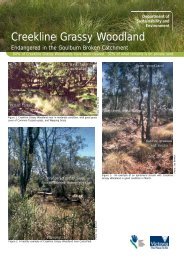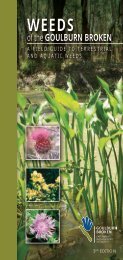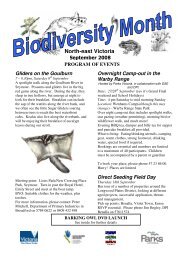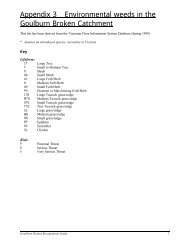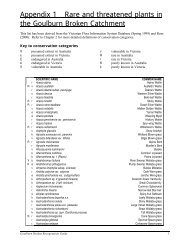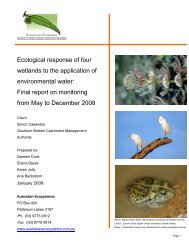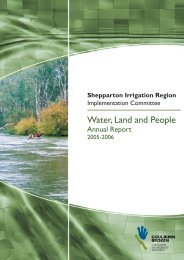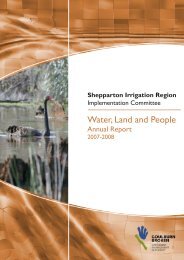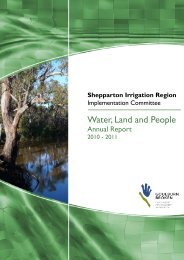Memorandum - Goulburn Broken Catchment Management Authority
Memorandum - Goulburn Broken Catchment Management Authority
Memorandum - Goulburn Broken Catchment Management Authority
Create successful ePaper yourself
Turn your PDF publications into a flip-book with our unique Google optimized e-Paper software.
<strong>Memorandum</strong><br />
To: Ken Sampson (for SIRIC and SIRTEC)<br />
Keith Chalmers, DPI (for SWMWG)<br />
Wayne Tennant, GBCMA<br />
Alex Marshall, MPE<br />
Anne Graesser, MWSH<br />
Ian Moorhouse, MWDS<br />
Carl Walters, MSU<br />
Area Managers & WSC – MV, Shep, CG, Rochester<br />
From: Greg Smith, Monitoring & Drainage Coordinator<br />
Subject: Nutrients in Drains in the Shepparton Irrigation Region 2005/06<br />
Date: 29 October 2007<br />
PURPOSE<br />
To provide information on nutrient loads discharged from surface drains in the Shepparton Irrigation<br />
Region between July 2005 and June 2006.<br />
BACKGROUND<br />
A review of nutrient levels in irrigation drains in the Shepparton Irrigation Region for 2005/2006 has<br />
been completed. Nutrient data is collected as part of project C806 “Monitoring of Nutrients in Drains<br />
in the Shepparton Irrigation Region”. The report summarises data collected from 15 drain monitoring<br />
sites in the <strong>Broken</strong>, <strong>Goulburn</strong> and Campaspe catchments. Data from Rices Weir, at the bottom of<br />
<strong>Broken</strong> Creek, <strong>Goulburn</strong> River at McCoys Bridge, River Murray at Torrumbarry and Campaspe River<br />
at Echuca are also included in the analysis.<br />
Data has been collected under this program since 1990. The number, and location of sites, has<br />
varied over this time. Water samples are collected and analysed fortnightly and this data is then<br />
coupled with continuous flow data to enable calculation of nutrient loads.<br />
The data is also used to calculate the overall export of nutrients from the <strong>Goulburn</strong>-<strong>Broken</strong> catchment<br />
and show the effects of implementation of the <strong>Goulburn</strong> <strong>Broken</strong> Water Quality Strategy and related<br />
catchment strategies.<br />
Funding for the drain monitoring program is provided by G-MW Irrigation Areas and the Shepparton<br />
Irrigation Region Implementation Committee of the <strong>Goulburn</strong> <strong>Broken</strong> <strong>Catchment</strong> <strong>Management</strong><br />
<strong>Authority</strong>.<br />
This paper provides a brief summary of the report and data. A full copy of the report can be provided<br />
on request or see GMW doc#2254360 or the GMW library.<br />
1
DISCUSSION<br />
Concentration of nutrients and suspended solids<br />
Water in irrigation drains continued to be of poorer quality than water in rivers and streams. Drainage<br />
water generally has high concentrations of total nitrogen (TN – medians generally >1 mg/L), total<br />
phosphorus (TP – medians > 0.1 mg/L) and filtered reactive phosphorus (FRP - medians > 0.01<br />
mg/L) although there is considerable variation between sites.<br />
� The highest median TN was 2.4 mg/L in Shepparton Drain 11 and the lowest was 0.69 mg/L in<br />
Rodney Main Drain.<br />
� The highest median TP was 0.77 mg/L in both MV Drain 6 and 13, while MV Drain 13 had the<br />
highest FRP of 0.38 mg/L (marginally above MV Drain 6).<br />
� The lowest median TP was 0.13 mg/L in Rodney Main Drain.<br />
Median concentrations of suspended solids (SS) were in the range 33 to 120 mg/L, slightly higher<br />
than the previous year. The Toolamba Drain median SS of 120 mg/L was the highest, whilst the<br />
Bamawm Drain recorded the lowest median. As a comparison, in lowland rivers SS is usually less<br />
than 30 mg/L.<br />
Nutrient Loads discharged from drains<br />
Loads of TN and TP discharged from drains overall were lower than the previous year and similar to<br />
2003/04. The same was true for annual flows, which tend to be the main factor determining loads. In<br />
2005/06:<br />
� MV Drain 6 discharged the largest load of TP (10.6t) and TN (20t), or 25% less after taking into<br />
account diversions downstream of the monitoring point. In the previous 2 years Deakin Drain<br />
discharged the largest nutrient loads.<br />
� Deakin Drain discharged the largest suspended sediment load of 581t, less than one third of the<br />
previous year.<br />
Irrigation water allocations in 2005/06 reached 100% WR in the <strong>Goulburn</strong> system in November, the<br />
same as in the previous two years. In the Murray system, the 2005/06 allocation reached 144% WR<br />
(15 April) whereas in the previous two years it only reached 100% WR.<br />
This raw load figure is useful as it indicates sources of large loads, but a more useful figure is<br />
kilograms of nutrient per hectare per year, known as a generation or export rate. This then takes the<br />
size of the catchment into account. Table 1 shows TP and SS export rates (note: length of record<br />
varies across sites). In 2005/06 most drain export rates were less than or equal to the all-years<br />
average export rates. As is 2004/05, Murray Valley Drain 6 had the highest TP export rate and<br />
Toolamba Drain the highest SS export rate. Export rates varied substantially between drains.<br />
Table 1. Irrigation Drain TP and SS export (or generation) rates (kg/ha/yr)<br />
Station<br />
Number Description<br />
TP kg/ha/yr all<br />
years<br />
2<br />
TP kg/ha/yr<br />
2005/06<br />
SS kg/ha/yr all<br />
years<br />
SS kg/ha/yr<br />
2005/06<br />
405297 Warrigal Creek 0.08 0.17 8 4<br />
405720 Rodney Main Drain, Wells Creek 0.37 0.23 39 25<br />
405730 Toolamba Depression 0.21 0.21 56 45<br />
405779 Shepparton Drain 11 0.08 0.10 10 7<br />
405758 Shepparton Drain 12 0.39 0.35 50 31<br />
406263 Mullers Creek at MV Highway 0.06 0.02 2 3<br />
406704 Deakin Main Drain Outfall 0.29 0.22 20 19<br />
406750<br />
Bamawm Main Drain at Dargan’s<br />
Bridge 0.48 0.34 33 21<br />
406756 Mosquito Creek at Curr Rd 0.07 0.07 9 3<br />
407712 Lockington Main Drain 0.16 0.03 15 7<br />
406758 Bamawm @ Richardsons Lagoon 0.12 0.07 8 3<br />
409711 Murray Valley Drain 3 0.12 0.05 43 0<br />
409712 Murray Valley Drain 6 1.06 0.61 78 22<br />
404712 Muckatah Drain outfall 0.01 0.00 0 0<br />
405232 <strong>Goulburn</strong> River @ McCoys 0.08 0.03 8 n/a<br />
(from doc#574896)
Drain Nutrient Loads over time<br />
The load of total phosphorus discharged from “monitored” drains since 1990/91 is shown in Figure 1<br />
(attached). [“Monitored” drains are Deakin, MV6, Rodney and Toolamba. These have been<br />
monitored since about 1990 and provide a means of looking at long term trends]. The graph shows<br />
that phosphorus loads declined in 2005/06 and are still below the long term target. The 5 year rolling<br />
average has also declined to a new low and remains well below the target value for reduction of<br />
nutrient loads from irrigation drains.<br />
The estimated phosphorus load for all drains is shown in Figure 2 and this plot has a similar shape to<br />
Figure 1.<br />
The total nitrogen load discharge from monitored drains is shown in Figure 3.<br />
Drain Flows<br />
Total estimated annual volume discharged from drains is shown in Figure 4. This shows drain flows<br />
over the past few years have been substantially lower than earlier years, with flows in 2002/03<br />
remaining the lowest on record. The 5 year rolling average continues to show a decline.<br />
<strong>Catchment</strong> Nutrient Load Export<br />
The overall tonnage of TP and TN exported from the <strong>Goulburn</strong> <strong>Broken</strong> catchment during 2004/05 was<br />
estimated to be 78 t TP and 558 t TN, compared to the long term average of 240 t TP and 1742 t TN<br />
respectively. Figures 5 and 6 show how these figures have varied since 1991/92.<br />
The Campaspe catchment exported 1.1 tonne TP and 8.4 tonne TN during 2004/05, which was well<br />
below the 5-year average.<br />
RECOMMENDATION<br />
For information.<br />
Greg Smith<br />
MONITORING & DRAINAGE COORDINATOR<br />
G-MW Doc Ref: 2337316<br />
G-MW File Ref: 2007/181/1<br />
3
Figure 1 (all figures from doc#309910)<br />
Total Phosphorus Load (kg)<br />
140,000<br />
120,000<br />
100,000<br />
80,000<br />
60,000<br />
40,000<br />
20,000<br />
Figure 2<br />
Total Phosphorus Load (kg)<br />
200,000<br />
180,000<br />
160,000<br />
140,000<br />
120,000<br />
100,000<br />
80,000<br />
60,000<br />
40,000<br />
20,000<br />
0<br />
0<br />
1990/91<br />
MV 6,<br />
Rodney,<br />
Deakin<br />
1990/91<br />
1991/92<br />
1991/92<br />
Toolamba<br />
1992/93<br />
1992/93<br />
TP loads from Monitored drains in <strong>Goulburn</strong>-<strong>Broken</strong> catchment<br />
(Deakin, Rodney, Toolamba, MV 6)<br />
1993/94 is the<br />
benchmark year<br />
1993/94<br />
1994/95<br />
1995/96<br />
1996/97<br />
1997/98<br />
4<br />
1998/99<br />
Year<br />
1999/2000<br />
2000/01<br />
2001/02<br />
2002/03<br />
Estimated Total Phosphorus Loads from all Irrigation Drains<br />
in the <strong>Goulburn</strong>-<strong>Broken</strong> catchment<br />
1993/94<br />
1994/95<br />
1995/96<br />
Benchmark Year<br />
Warrigal Ck,<br />
MV 3<br />
Timeline when drains added to monitoring program<br />
(TP load estimated for unmonitored drains & periods)<br />
1996/97<br />
Shep 11<br />
& 12<br />
1997/98<br />
1998/99<br />
year<br />
1999/2000<br />
2000/01<br />
2001/02<br />
2002/03<br />
2003/04<br />
2003/04<br />
Annual load<br />
5 year rolling average<br />
Target (monitored drains)<br />
2004/05<br />
2004/05<br />
2005/06<br />
Total estimated Annual Load (update)<br />
5 year rolling average of Annual Load<br />
Target (50% of 93/94 load)<br />
2005/06
Figure 3<br />
Total Nitrogen Load (kg)<br />
450,000<br />
400,000<br />
350,000<br />
300,000<br />
250,000<br />
200,000<br />
150,000<br />
100,000<br />
50,000<br />
Figure 4<br />
Annual Flow (ML/yr)<br />
350,000<br />
300,000<br />
250,000<br />
200,000<br />
150,000<br />
100,000<br />
50,000<br />
0<br />
0<br />
1990/91<br />
1991/92<br />
Total Nitrogen loads from Monitored drains in <strong>Goulburn</strong>-<strong>Broken</strong> catchment<br />
(Deakin, Rodney, Toolamba, MV 6)<br />
1992/93<br />
1993/94<br />
1994/95<br />
1995/96<br />
1996/97<br />
1997/98<br />
5<br />
1998/99<br />
Year<br />
1999/2000<br />
Estimated Annual Flows from all Irrigation Drains in <strong>Goulburn</strong> <strong>Broken</strong> catchment<br />
2000/01<br />
2001/02<br />
2002/03<br />
2003/04<br />
Annual load<br />
5 year rolling average<br />
1990/91 1991/92 1992/93 1993/94 1994/95 1995/96 1996/97 1997/98 1998/99 1999/2000 2000/01 2001/02 2002/03 2003/04 2004/05 2005/06<br />
2004/05<br />
2005/06<br />
Total estimated Annual Flow (update)<br />
5 year rolling average of Total Annual Flow
Figure 5<br />
Total Phosphorus (tonnes/year)<br />
800<br />
700<br />
600<br />
500<br />
400<br />
300<br />
200<br />
100<br />
0<br />
Figure 6<br />
Total Nitrogen (tonnes/year)<br />
6000<br />
5000<br />
4000<br />
3000<br />
2000<br />
1000<br />
0<br />
Total Phosphorus exported from <strong>Goulburn</strong>-<strong>Broken</strong> catchment<br />
1991/92 1992/93 1993/94 1994/95 1995/96 1996/97 1997/98 1998/99 1999/00 2000/01 2001/02 2002/03 2003/04 2004/05 2005/06<br />
6<br />
Year<br />
Total Nitrogen exported from <strong>Goulburn</strong>-<strong>Broken</strong> catchment<br />
Annual<br />
Target (65% of 93/94 level)<br />
5-yr rolling avg<br />
1991/92 1992/93 1993/94 1994/95 1995/96 1996/97 1997/98 1998/99 1999/00 2000/01 2001/02 2002/03 2003/04 2004/05 2005/06<br />
Year<br />
Annual<br />
Average<br />
5-yr rolling avg



